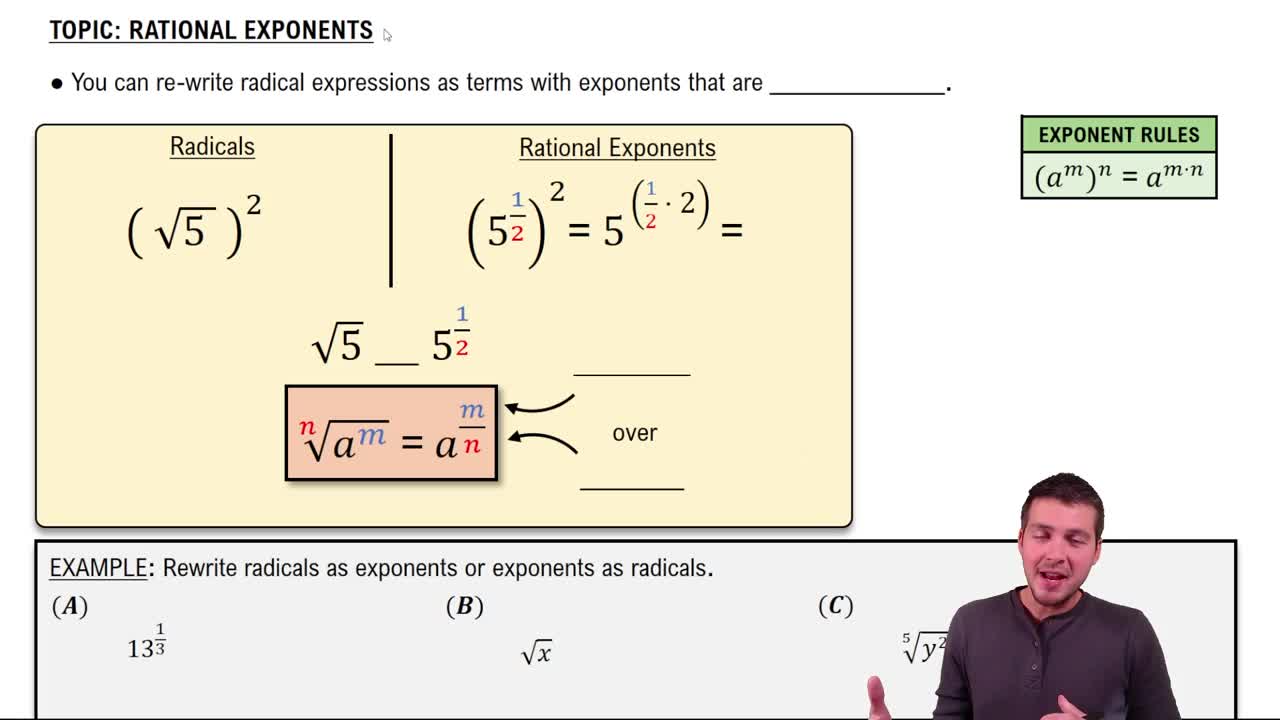Table of contents
- 0. Review of Algebra4h 16m
- 1. Equations & Inequalities3h 18m
- 2. Graphs of Equations43m
- 3. Functions2h 17m
- 4. Polynomial Functions1h 44m
- 5. Rational Functions1h 23m
- 6. Exponential & Logarithmic Functions2h 28m
- 7. Systems of Equations & Matrices4h 6m
- 8. Conic Sections2h 23m
- 9. Sequences, Series, & Induction1h 19m
- 10. Combinatorics & Probability1h 45m
0. Review of Algebra
Rational Exponents
Problem 105
Textbook Question
Simplify each expression. Write answers without negative exponents. Assume all vari-ables represent positive real numbers. See Examples 8 and 9. (p^1/5p^7/10p^1/2)/(p^3)^-1/5
 Verified step by step guidance
Verified step by step guidance1
First, simplify the expression in the numerator: \( p^{1/5} \cdot p^{7/10} \cdot p^{1/2} \).
Combine the exponents in the numerator by adding them: \( \frac{1}{5} + \frac{7}{10} + \frac{1}{2} \).
Convert all fractions to have a common denominator and add them together.
Simplify the expression in the denominator: \( (p^3)^{-1/5} \) which is equivalent to \( p^{-3/5} \).
Divide the simplified numerator by the simplified denominator by subtracting the exponents: \( p^{\text{numerator exponent} - (-3/5)} \).
Recommended similar problem, with video answer:
 Verified Solution
Verified SolutionThis video solution was recommended by our tutors as helpful for the problem above
Video duration:
3mPlay a video:
Was this helpful?
Key Concepts
Here are the essential concepts you must grasp in order to answer the question correctly.
Exponent Rules
Understanding exponent rules is crucial for simplifying expressions involving powers. Key rules include the product of powers (a^m * a^n = a^(m+n)), the quotient of powers (a^m / a^n = a^(m-n)), and the power of a power (a^(m*n) = a^mn). These rules help in combining and simplifying terms effectively.
Recommended video:
Guided course

Introduction to Exponent Rules
Negative Exponents
Negative exponents indicate the reciprocal of the base raised to the opposite positive exponent (a^-n = 1/a^n). In simplification, it's important to convert negative exponents to positive ones to adhere to the problem's requirement of expressing answers without negative exponents, which often involves rewriting the expression.
Recommended video:
Guided course

Zero and Negative Rules
Simplifying Rational Expressions
Simplifying rational expressions involves reducing fractions to their simplest form by canceling common factors in the numerator and denominator. This process often requires applying exponent rules and ensuring that all variables are treated as positive real numbers, which affects how we handle the exponents in the expression.
Recommended video:
Guided course

Simplifying Algebraic Expressions

 4:06m
4:06mWatch next
Master Rational Exponents with a bite sized video explanation from Patrick Ford
Start learningRelated Videos
Related Practice


